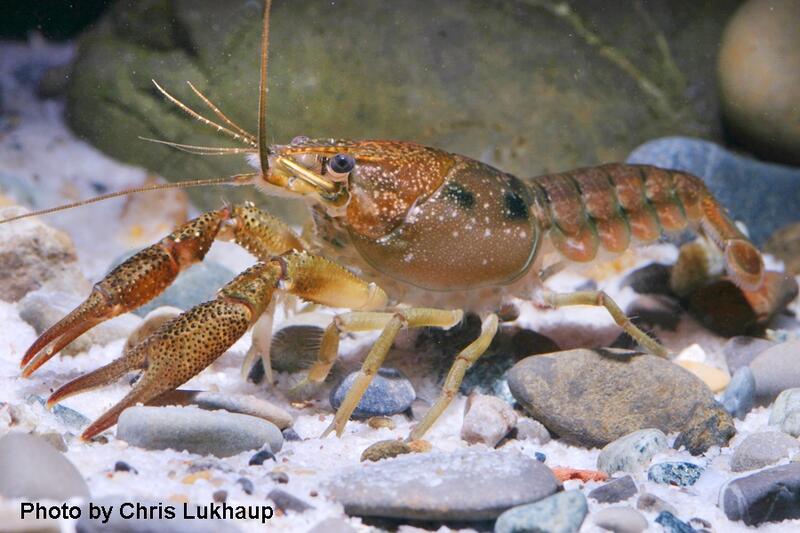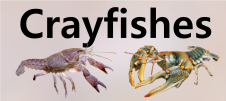







Loading profile. Please wait . . .
Procambarus litosternum Hobbs, 1947
Blackwater Crayfish




Federal Protection: No US federal protection
State Protection: No Georgia state protection
Global Rank: G4
State Rank: S4
Element Locations Tracked in Biotics: No
SWAP 2015 Species of Greatest Conservation Need (SGCN): No
SWAP 2025 Species of Greatest Conservation Need (SGCN): No
2025 SGCN Priority Tier: None
Element Occurrences (EOs) in Georgia: 0
Habitat Summary for element in Georgia: Associated with vegetation, woody debris, or undercut banks in permanent streams
The overall color of the Blackwater Crayfish is light brown to tan with whitish speckling and splotches. There are two dark spots on either side of the carapace and a pale (sometimes indistinct) stripe down the center of the carapace. The abdomen has a broad, dark indistinct longitudinal stripe. The claws are brown with dark tubercles. The areola is moderately broad and there is a single cervical spine on each side of the cephalothorax. The rostrum is long, tapering, and has marginal spines or tubercles. This species reaches a maximum total body length of about 82 mm (3.2 in).
The Blackwater Crayfish has been collected with several other Procambarus species including the White River Crawfish (Procambarus acutus), Black Mottled Crayfish (P. enoplosternum), Hummock Crayfish (P. lunzi), and Eastern Red Swamp Crawfish (P. troglodytes). All but the Black Mottled Crayfish have a narrower areola than the Blackwater Crayfish and none (except sometimes Black Mottled) have discrete dark spots on the upper sides of the carapace. Black Mottled Crayfish differs from Blackwater Crayfish by having a dark saddle at the rear of the carapace.
The Blackwater Crayfish is primarily a stream dweller usually associated with some sort of cover, particularly vegetation and undercut banks. It may also be found in leaf litter or associated with rocks or woody debris.
No studies of the Blackwater Crayfish are known. Crayfishes are considered opportunistic omnivores and likely feed on live and decaying vegetation, aquatic insect larvae, small fishes, and dead animal matter.
Male Blackwater Crayfish in reproductive condition have been collected in March, April, May, June, and December and no females with eggs have been collected. The smallest male in reproductive condition is about 56 mm (2.2 in) in length (Hobbs 1981). Since no females with eggs have been found it is likely that they retreat to burrows to lay eggs and rear young.
Since this species is usually found in flowing water, it is most easily collected by holding a net perpendicular to the current downstream of vegetation or woody debris and kicking to dislodge and scare crayfish into the net. If there are rocks or logs in the creek, they may be carefully lifted and crayfish may be pinned by hand or coaxed into a dipnet. Using a backpack electroshocker or baited minnow traps set overnight can be effective as well.
The Blackwater Crayfish is endemic to Georgia and found in the lower Ogeechee, Canoochee, and Newport river systems.
This species is threatened in Georgia by land uses within its range that could alter hydrology and water quality. Introduction of non-native species is a threat to all native crayfishes.
Although it has a somewhat restricted range in Georgia, this species is considered secure.
General watershed level protection measures will help secure the continued existence of the Blackwater Crayfish in Georgia. These include the protection of riparian zones, control of sediment and nutrient runoff from farms and construction sites, and limiting the amount of impervious cover (e.g., pavement) within occupied watersheds. Non-native crayfishes should never be used for bait. Instead, anglers should use crayfishes collected from the river system they will be fishing in and should never release unused bait crayfish back into Georgia waters.
Hobbs, H.H., Jr. 1981. The crayfishes of Georgia. Smithsonian Contributions to Zoology 318:1–549.
Taylor, C.A., G.A. Schuster, J.E. Cooper, R.J. DiStefano, A.G. Eversole, P. Hamr, H.H. Hobbs III, H.W. Robison, C.E. Skelton, and R.F. Thoma. 2007. A reassessment of the conservation status of crayfishes of the United States and Canada after 10+ years of increased awareness. Fisheries 32:372–389.
Christopher E. Skelton
C. Skelton, September 2012: original account
C. Skelton, March 2019: general update of account.
D.Weiler, September 2019: photo added